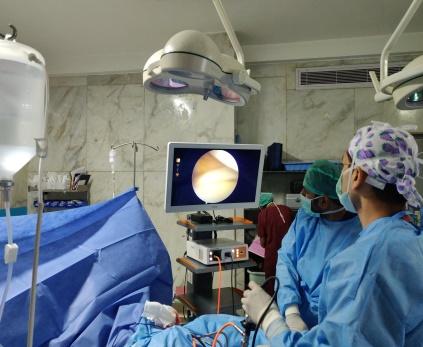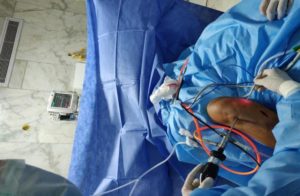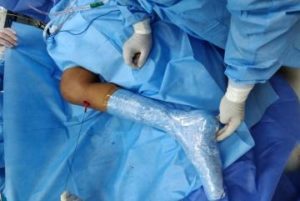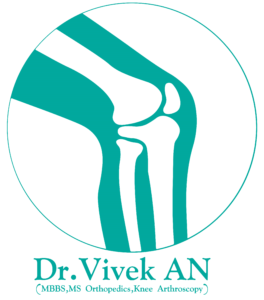What is the role of Anterior Cruciate Ligament (ACL) in normal knee function?
ACL is one of the two key ligaments of knee for providing stability(PCL is the other ligament). A knee in which ACL is torn, may give rise to instability, which is experienced as ‘giving-way’ or slipping. ACL prevents forward sliding of thigh bone (femur) over the leg bone (tibia). This instability is felt while walking, turning (cutting activities), running and descending from stairs.


What is the need for ACL Reconstruction Surgery?
Important aspects of ACL reconstruction are
- (i) Provide knee stability
- (ii) Restore normal activities
- (iii) Maintain the normal longevity of the knee joint
What is done in ACL Reconstruction Surgery?
ACL reconstruction as the name implies, making a new ACL, since repair of the torn ligament will not work. The surgery is performed under anaesthesia in an operating room equipped with instruments to perform arthroscopic (Key-hole) procedures. The entire procedure takes about 45 to 60 minutes. After initial cleaning and draping of the affected knee, two small (5mm) portals or incisions are made on the skin. Through these portals, the entire surgery is performed. One hole is used to place the camera into the joint and the other hole is called the working portal through which surgery is performed using tiny specialized instruments. Initial step involves doing a reconnaissance of the knee which is called ‘diagnostic arthroscopy’ to note, confirm and correlate with the MRI images.




What is done in ACL Reconstruction Surgery?
ACL reconstruction as the name implies, making a new ACL, since repair of the torn ligament will not work. The surgery is performed under anaesthesia in an operating room equipped with instruments to perform arthroscopic (Key-hole) procedures. The entire procedure takes about 45 to 60 minutes. After initial cleaning and draping of the affected knee, two small (5mm) portals or incisions are made on the skin. Through these portals, the entire surgery is performed. One hole is used to place the camera into the joint and the other hole is called the working portal through which surgery is performed using tiny specialized instruments. Initial step involves doing a reconnaissance of the knee which is called ‘diagnostic arthroscopy’ to note, confirm and correlate with the MRI images.
The next step involves harvesting the graft, which will become the new ACL. Normally the hamstring tendons are used namely semitendinosus and/or gracilis. These are taken through a small 3cm incision over the upper leg. This same incision is further used in the next step where holes are made in the thigh bone (femur) and leg bones (tibia). In the meantime, the surgeon or the assistant surgeon ‘prepares’ the graft and notes the size and dimensions. Then drill holes are made in the bones through which the graft is passed and it is fixed with a small button (7mm) on one side and a screw (metallic or bioabsorbable) on other side. The wounds are closed using staples or simple stitches.
Will need bed rest after surgery?
You will be hospitalized for 2-3 days for the surgery. You will be able to walk without support within 12 hours after the surgery, able to use stairs (as an exercise) after 24 -36 hours. At discharge from the hospital on the third day, you will be able to take care of yourself for your needs. So, no bed rest is needed, however, you will not be allowed to cycle, use a bike, run or sit on the floor for 6-8 weeks from surgery.
What are the complications or “side-effects” of ACL surgery?
Bleeding and infection are usual complications that can occur after any surgery. Since this surgery is done by arthroscopy (key-hole) and involves minimal damage to tissues, chances of bleeding and infection are remote. In my 12 years of experience with more than 2,500 arthroscopic surgeries, I have encountered infection in very few cases (less than 0.5%). However, issues like stiffness and recurrent giving way may be seen which is mainly due to non-compliance of physiotherapy protocols.


What is done in ACL Reconstruction Surgery?
ACL reconstruction as the name implies, making a new ACL, since repair of the torn ligament will not work. The surgery is performed under anaesthesia in an operating room equipped with instruments to perform arthroscopic (Key-hole) procedures. The entire procedure takes about 45 to 60 minutes. After initial cleaning and draping of the affected knee, two small (5mm) portals or incisions are made on the skin. Through these portals, the entire surgery is performed. One hole is used to place the camera into the joint and the other hole is called the working portal through which surgery is performed using tiny specialized instruments. Initial step involves doing a reconnaissance of the knee which is called ‘diagnostic arthroscopy’ to note, confirm and correlate with the MRI images.
Is ACL surgery and aftermath painful?
As mentioned, surgery will be done under anaesthesia. To keep pain at bay after surgery, we use advanced techniques of nerve blocks and cryotherapy and minimalistic use of pain medications. Postoperative DVT prophylaxis (Deep Vein Thrombosis) is followed as per international standards.
Do I need a physiotherapist or a trainer after ACL surgery?
For most young adults who undergo ACL reconstruction, I prescribe and demonstrate simple exercises which needs to be followed stringently. If the anticipated recovery is slower or the situation requires special attention (Professional sportsmen), I recommend specific therapists to attain results.
How much does the surgery cost?
ACL reconstruction is one of the most commonly performed surgeries in orthopaedics. Treatment is fully covered under any valid health insurance policy, without any waiting period (since it is an emergency/ following injury or accident). Estimate of surgery is Rs 1,40,000 -1,60,000/- which includes single AC room for 3 days, surgeon, assistant and anaesthetists fees, operation room and equipment charges and implants.
Contact Address
Fortis Malar Hospital,
No. 52, Ist Main Road,
Gandhi Nagar, Adyar,
Chennai - 600020
Tamil Nadu, India
Get Direction
Copyrights © Dr Vivek | All Rights Reserved
Powered & Maintained by Altus Quantum
+91 98846 77890
+91 93846 79989

What is the role of Anterior Cruciate Ligament (ACL) in normal knee function?
ACL is one of the two key ligaments of knee for providing stability(PCL is the other ligament). A knee in which ACL is torn, may give rise to instability, which is experienced as ‘giving-way’ or slipping. ACL prevents forward sliding of thigh bone (femur) over the leg bone (tibia). This instability is felt while walking, turning (cutting activities), running and descending from stairs.
What is the need for ACL Reconstruction Surgery?
Important aspects of ACL reconstruction are
(i) Provide knee stability
(ii) Restore normal activities
(iii) Maintain the normal longevity of the knee joint
– this is the most important reason, according to me, for ACL Reconstruction since frequent episodes of giving-way and slipping will lead to injury to the supporting ligaments(mainly meniscus) and the smooth joint cartilage which are responsible for the longevity of the joint. For younger adults and active elderly without arthritis of knee it is important to preserve the stability and hence the longevity of the joint.


What is done in ACL Reconstruction Surgery?
ACL reconstruction as the name implies, making a new ACL, since repair of the torn ligament will not work. The surgery is performed under anaesthesia in an operating room equipped with instruments to perform arthroscopic (Key-hole) procedures. The entire procedure takes about 45 to 60 minutes. After initial cleaning and draping of the affected knee, two small (5mm) portals or incisions are made on the skin. Through these portals, the entire surgery is performed. One hole is used to place the camera into the joint and the other hole is called the working portal through which surgery is performed using tiny specialized instruments. Initial step involves doing a reconnaissance of the knee which is called ‘diagnostic arthroscopy’ to note, confirm and correlate with the MRI images.





The next step involves harvesting the graft, which will become the new ACL. Normally the hamstring tendons are used namely semitendinosus and/or gracilis. These are taken through a small 3cm incision over the upper leg. This same incision is further used in the next step where holes are made in the thigh bone (femur) and leg bones (tibia). In the meantime, the surgeon or the assistant surgeon ‘prepares’ the graft and notes the size and dimensions. Then drill holes are made in the bones through which the graft is passed and it is fixed with a small button (7mm) on one side and a screw (metallic or bioabsorbable) on other side. The wounds are closed using staples or simple stitches.

Will need bed rest after surgery?
You will be hospitalized for 2-3 days for the surgery. You will be able to walk without support within 12 hours after the surgery, able to use stairs (as an exercise) after 24 -36 hours. At discharge from the hospital on the third day, you will be able to take care of yourself for your needs. So, no bed rest is needed, however, you will not be allowed to cycle, use a bike, run or sit on the floor for 6-8 weeks from surgery.
What are the complications or “side-effects” of ACL surgery?
Bleeding and infection are usual complications that can occur after any surgery. Since this surgery is done by arthroscopy (key-hole) and involves minimal damage to tissues, chances of bleeding and infection are remote. In my 12 years of experience with more than 2,500 arthroscopic surgeries, I have encountered infection in very few cases (less than 0.5%). However, issues like stiffness and recurrent giving way may be seen which is mainly due to non-compliance of physiotherapy protocols.
Is ACL surgery and aftermath painful?
As mentioned, surgery will be done under anaesthesia. To keep pain at bay after surgery, we use advanced techniques of nerve blocks and cryotherapy and minimalistic use of pain medications. Postoperative DVT prophylaxis (Deep Vein Thrombosis) is followed as per international standards.
Do I need a physiotherapist or a trainer after ACL surgery?
For most young adults who undergo ACL reconstruction, I prescribe and demonstrate simple exercises which needs to be followed stringently. If the anticipated recovery is slower or the situation requires special attention (Professional sportsmen), I recommend specific therapists to attain results.
How much does the surgery cost?
ACL reconstruction is one of the most commonly performed surgeries in orthopaedics. Treatment is fully covered under any valid health insurance policy, without any waiting period (since it is an emergency/ following injury or accident). Estimate of surgery is Rs 1,40,000 -1,60,000/- which includes single AC room for 3 days, surgeon, assistant and anaesthetists fees, operation room and equipment charges and implants.
Contact Address
Fortis Malar Hospital,
No. 52, Ist Main Road,
Gandhi Nagar, Adyar,
Chennai – 600020
Tamil Nadu, India
Contact Details
+91 98846 77890
+91 93846 79989
Get Direction
Copyrights © Dr Vivek | All Rights ReservedPowered & Maintained by Altus Quantum


